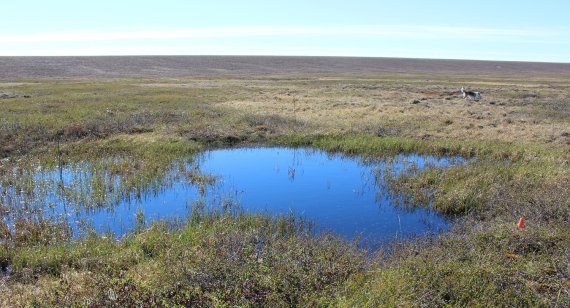© Ronny Rotbarth
No ecosystem is suffering more from global warming than the tundra and taiga biomes on permafrost. This is evident from the report published by the IPCC yesterday. Even if the temperature increase remains below two degrees, one quarter of the top layer (up to four metres deep) of the permafrost will have thawed by the end of the century. If the rise in temperature accelerates, as much as three quarters of the permafrost may vanish. Our planet is melting and decaying, resulting in huge emissions of greenhouse gases.
Yakutia
But the uncertainties in the climate models are very large. Ecologist Monique Heijmans agrees that the thawing process is complicated. Since 2007, she has been carrying out research in Yakutia, a federal republic the size of India in the far northeast of Russia. Last summer, she was there again to help her PhD candidate Rúna Magnússon with her work. Magnússon investigates the relationship between vegetation, climate change and the state of permafrost in the delta of the Indigirka river.
We therefore started an irrigation test last year to simulate a wet summer.
Monique Heijmans
‘Global warming is thawing the soil’, Heijmans explains. ‘This is a direct consequence of climate change. In addition, precipitation also plays an important role in the thawing process. The first indication of this was the wet summer of 2011. In that year, the thaw turned out to be more significant than in other years: 30 centimetres, whereas the average is 20-25 centimetres. We therefore started an irrigation test last year to simulate a wet summer.’
The additional water also caused faster thawing. Not only in the year in which the irrigation took place: the effect was still noticeable this year. ‘This means that there is a lag in the thawing too’, Heijmans concludes. ‘The additional thaw may cause the soil to collapse due to the melting of ice layers in the permafrost. Satellite photos confirm this image; we see more water in our research area.’ The thaw drowns the previously present vegetation in the resulting pools.
Recovery
This finding is at odds with the prevailing notion that warming is actually greening Arctic regions. Although that may still be true, Heijmans thinks. The regular succession of species starts in the created pools, from aquatic plants via peat moss to the final original shrub vegetation. ‘The first steps in the process are fairly quick. Recovery therefore seems possible. The only unknown remaining is which process is faster: the thaw due to climate change or the growth in the pools. That is the big question.’
According to Heijmans, global warming is already tangible. ‘The locals notice that it is getting warmer and that things are changing. Last summer, they saw a tundra fire for the first time. June was extremely hot and dry. One usually needs boots when walking on the tundra. It is a swampy area, because the thawed water cannot drain through the frozen subsoil. Those boots weren’t necessary this summer.’
Additional reading:
Disturbing tundra makes permafrost melt faster


